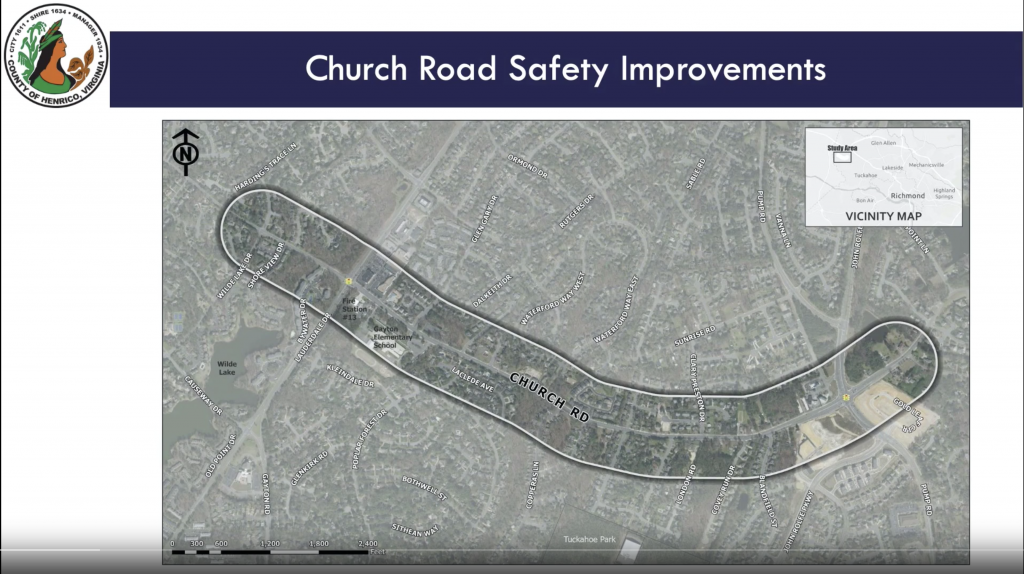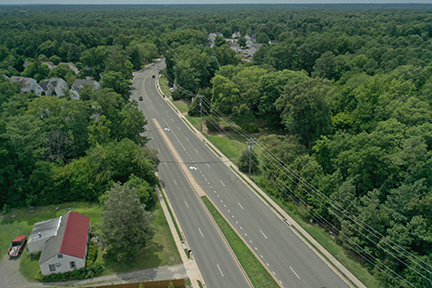1.8-mile project will enhance safety, connectivity for bicyclists and pedestrians
A four-lane stretch of Church Road will be reconfigured this summer in a “road diet” conversion aimed at enhancing safety as well as connectivity for bicyclists and pedestrians.
The 1.8-mile portion between Wilde Lake Drive, near Lauderdale Drive, and Chapelwood Lane, near John Rolfe Parkway, will be repaved and restriped to create two travel lanes, a center turn lane and a buffered bike lane on each side.
The project, approved July 13 by the Board of Supervisors, also will provide curb ramps, median islands, signs and traffic signal modifications. Finley Asphalt & Sealing is expected to start work in August and finish in 45 days.

Church’s conversion is the type of project that can be replicated easily on four-lane, undivided roads with excess capacity because it reallocates how the pavement is used, said Terrell Hughes, director of the Department of Public Works.
In relative terms, it is an economical way to create bike lanes. Seventy-five percent of the project’s $1.2 million cost will cover the repaving, which was already slated to occur.
“That’s our big thing,” Hughes said. “As opportunities arise, we’re trying to increase our pedestrian and bike connectivity.”
Traffic engineers use “road diet” to describe the conversion of an undivided, four-lane road to a three-lane road, with two through lanes and a center lane for left turns. The redesign can bring a 19% to 47% reduction in crashes as well as lower speeds and improved access and mobility for all users, according to the Federal Highway Administration.
Church was a strong candidate for conversion because it is due for resurfacing and residents recognized the benefits, Hughes said. In a survey, 71% of 426 respondents preferred the Option 3 proposal for dual bike lanes and a median over two alternatives. Church’s four-lane stretch attracts about 8,500 vehicles per day and connects two-lane sections to its east and west.
The pending reconfiguration also dovetails with earlier initiatives to address safety concerns along the curvy road, which is home to Gayton Elementary School and provides access to Deep Run Park and nearby stores and restaurants.


In June 2019, Public Works reduced the posted speed limit to 35 mph on Church’s 3-mile stretch between Three Chopt Road and Lauderdale Drive as well as on Park Terrace. The speed limit in those areas had been 45 mph.
“Immediately, we started seeing improvements,” Hughes said.
Vehicle crashes on Church dropped from 14 in 2018 – before the change – to five in 2019, none in 2020 and two in the first six months of 2021. In addition, the average speed dropped by 5.8 mph, from 49.8 mph in 2016 and 2018 to 44 mph in 2019.
Hughes credited residents and the homeowners’ associations along the corridor for helping to shape the plan.
“We hear the residents of the county, and we’re actively working countywide on improvements that can be made,” he said.
Public Works sees the potential for similar road conversions on Dumbarton and Dickens roads in Lakeside and hopes to present proposals to the community late this year or early next year.
“We’re starting to see the benefits of slowing things down a bit,” Hughes said. “You can accommodate both cars and pedestrians without sacrificing either.”







